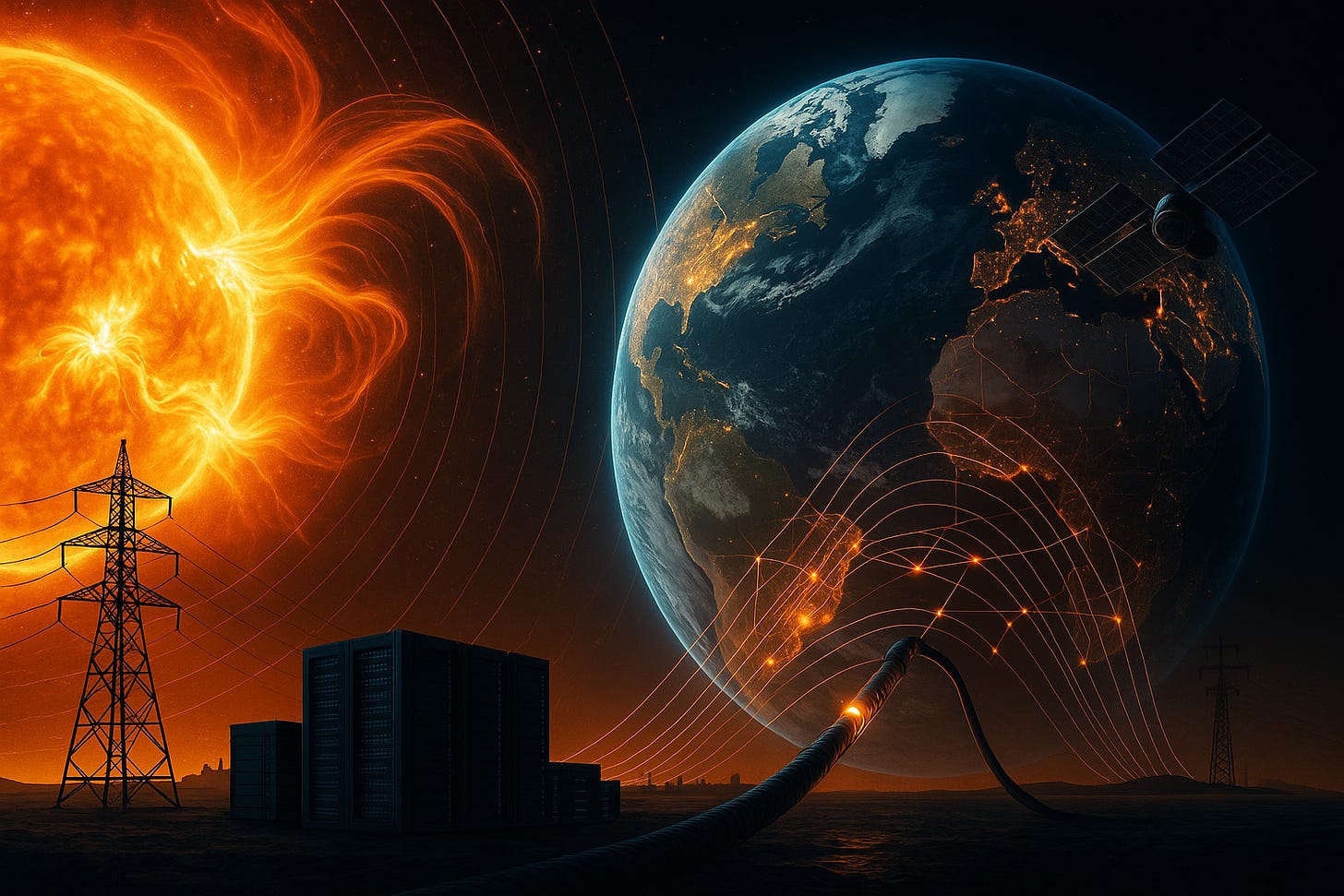Introduction
In July 2012, Earth narrowly missed disaster when a powerful coronal mass ejection passed harmlessly above our atmosphere. Had it struck, experts believe it would have rivaled the historic Carrington Event of 1859. Today, artificial intelligence and blockchain technologies are woven into commerce, governance, and daily life. Automated trading algorithms execute orders in microseconds, machine-learning models manage power grids in real time, and decentralized ledgers secure trillions in value. These systems require uninterrupted computing power, network connectivity, and electricity. A direct hit from a Carrington-level solar storm could sever that backbone within minutes, triggering cascading failures across every sector of our economy.
AI and Blockchain: The New Critical Infrastructure
Planetary-Scale AI Automation
Over the next decade, AI agents will optimize everything from energy dispatch to healthcare diagnostics. Smart-grid controllers will balance renewable and conventional generation. Autonomous vehicles will coordinate routes dynamically. Financial institutions will depend on machine-learning models for fraud detection and high-frequency trading. In medicine, neural networks will analyze imaging studies faster than human radiologists.
All these capabilities rely on vast data centers running 24/7. A prolonged outage would force every system back to manual procedures, slowing processes dramatically and eroding confidence in AI reliability.
Decentralized Trust via Blockchain
Blockchain networks now underpin decentralized finance platforms that lock up hundreds of billions in assets. They record ownership of digital and physical goods, authenticate identities, and execute smart contracts for insurance, supply-chain management, and cross-border payments.
The security of these networks depends on geographically distributed validator nodes. If a Carrington-level storm takes many nodes offline for days or weeks, the ledger could split into incompatible forks, freezing assets and undermining faith in blockchain as a trust layer.
Edge-to-Cloud Interdependence
The Internet of Things has created millions of edge devices that perform local data collection before synchronizing with cloud and blockchain backends. Smart city infrastructure relies on constant connectivity to central analytics platforms.
A data-center blackout would strand edge devices with expired authentication tokens and no route to offload critical data. The result: autonomous vehicles stuck in traffic, medical devices running outdated protocols, and industrial plants operating blind.
Lessons from the Past
1859 Carrington Event
When British astronomer Richard Carrington observed the largest recorded solar flare in 1859, telegraph lines across Europe and North America carried such strong induced currents that operators received electric shocks and paper caught fire. Auroras appeared near the equator, visible as far south as Cuba and Hawaii.
1921 Railroad Storm
In May 1921, a geomagnetic storm overloaded telephone switching equipment in New York and Massachusetts, sparking fires. Railroads reported irregular compass readings, hampering navigation.
1989 Quebec Blackout
A CME in March 1989 crashed into Earth's magnetosphere and generated currents that tripped the Hydro-Québec power grid, leaving six million people without power for nine hours. Transformers in New York State experienced heating and damage. The financial impact exceeded hundreds of millions of dollars, and damaged transformers required months to replace.
2003 Halloween Storms
A series of intense solar events in October 2003 caused satellite anomalies, disrupted GPS signals, and forced airlines to reroute flights away from polar routes. While modern infrastructure endured, the episode underscored the global reach of powerful CMEs.
Each of these events was less intense than a full-Carrington storm, yet each demonstrated society's vulnerability to space weather—a vulnerability that grows alongside technological complexity.
The Risk Equation
Likelihood Models
Though Carrington-scale events occur on average once per century, updated solar-activity models suggest a roughly 1–4 percent chance per decade of a direct hit. As society's dependence on digital infrastructure intensifies, the consequences of even a low-probability event escalate dramatically.
Economic Stakes
Recent risk assessments estimate that a Carrington-level storm could impose up to $2.4 trillion in global economic losses over five years. In the immediate aftermath, daily GDP losses may reach tens of billions as supply chains halt, financial markets freeze, and emergency services strain.
In the United States alone, 20–40 million people could face power outages lasting weeks to years if multiple high-voltage transformers fail simultaneously.
The Technical Threat
Geomagnetically Induced Currents
A CME's magnetic field perturbs Earth's magnetosphere, creating fluctuations that induce currents in long conductors—power transmission lines, undersea cables, pipelines, and rail tracks.
These currents drive continuous magnetization in transformer cores, leading to:
Core saturation that reduces transformer efficiency
Excessive heating that degrades insulation
Protective relay trips that disconnect substations in cascading sequences
Transformer Vulnerability
Modern transformers prioritize efficiency with thin core laminations and compact designs. These features minimize energy losses under normal operation but worsen susceptibility to geomagnetic currents.
Replacement of large transformers can take 9–12 months due to manufacturing complexity. Utilities maintain limited spare pools, often insufficient for multiple simultaneous failures.
Undersea Cable and Satellite Risks
Undersea fiber-optic cables depend on powered repeaters every 50–100 kilometers. A geomagnetic surge can destroy repeater electronics, severing intercontinental connectivity.
Satellites exposed to high-energy particles face memory corruption and solar-panel degradation, compromising GPS timing, communications, and remote sensing capabilities.
Backup System Limitations
Data-center backup generators and uninterruptible power supplies are engineered for short outages—typically hours, not days or weeks. Fuel tanks often hold 2–4 days of diesel; microgrids combining solar panels and battery banks require grid synchronization to recharge.
Why We Aren't Prepared
Low-Frequency, High-Impact Bias
Risk managers focus on frequent threats—cyberattacks, hurricanes, earthquakes—because they appear in historical loss data. Century-scale events like Carrington-level storms fall outside typical planning horizons.
Regulatory and Standards Gaps
Reliability standards mandate cybersecurity and physical security measures but often don't require protection against geomagnetic disturbances. Data-center certification programs assume grid availability, ignoring scenarios of prolonged blackouts.
Economic Disincentives
Retrofitting existing equipment with geomagnetic protection represents significant capital expenditure. Infrastructure operators often prioritize more visible investments in cybersecurity and renewable energy over space-weather risks.
Operational Blind Spots
Few enterprises integrate real-time solar-storm forecasts into their operations or automate preemptive responses. As a result, managers lack situational awareness and fail to initiate graceful shutdown protocols before a CME's arrival.
Recent Advances
Transformer Design Innovations
Researchers have developed alternative core alloys that reduce geomagnetic current penetration by up to 40 percent. Pilot projects demonstrate improved resilience, but widespread upgrades remain limited by costs.
Grid-Hardening Initiatives
Series capacitors and neutral-blocking devices installed at select substations have proven effective in blocking destructive currents. However, funding disputes slow widespread deployment.
AI-Enhanced Forecasting
NASA, NOAA, and European agencies now employ machine-learning models to simulate CME propagation, offering 24–48 hours of lead time—double the warning provided by earlier models.
Despite these advances, adoption remains uneven, and many critical systems remain at risk.
Building Resilience: Practical Steps
Hardware Protection
Enclose critical infrastructure in Faraday shields rated for low-frequency magnetic fields
Install surge protection devices on power and data lines entering critical equipment
Deploy hardware-level data corruption detection and automatic recovery mechanisms
Power Redundancy
Maintain on-site fuel reserves for at least 30 days of generator operation
Implement microgrids combining solar arrays, wind turbines, and hydrogen fuel cells
Design systems to gracefully degrade rather than catastrophically fail
Geographic and Network Diversity
Site new data centers at lower geomagnetic latitudes, where storm effects are weaker
Contract with multiple undersea and terrestrial cable providers
Implement automated traffic rerouting around damaged network links
Emergency Preparation
Conduct regular blackout exercises that validate each transition step and recovery timeline
Subscribe to space weather prediction services via API and integrate alerts into operations
Develop preconfigured scripts to throttle workloads and isolate storage before predicted CME impact
Cross-Sector Coordination
Establish resilience consortiums comprising utilities, data centers, and satellite providers
Advocate for regulatory frameworks mandating geomagnetic disturbance protection
Create emergency communication channels that can function when primary networks fail
Beyond Technology: The Human Dimension
When digital systems fail, society must maintain essential services:
Critical Infrastructure
Water treatment plants must shift to manual operation of valves and pumps
Food distribution requires paper-based inventory tracking and prioritization
Healthcare facilities need backup power and contingency plans for electronic record outages
Public Response
Emergency services must coordinate through alternative communication channels
Communities need neighborhood-level response hubs with radio and satellite links
Public information campaigns should prepare citizens for prolonged service disruptions
Conclusion
Artificial intelligence and blockchain have become the nervous system of modern civilization. Yet a Carrington-level solar storm could dismantle power grids, sever global communications, and halt data centers for months—threatening economic collapse and social upheaval.
The path forward demands technical hardening of hardware, robust backup systems, realistic emergency drills, and global coordination among stakeholders. Equally vital is preparing for the human dimension of recovery—ensuring water, food, healthcare, and public safety endure amid digital blackouts.
The next extreme solar storm is not a matter of if but when. We must act now to safeguard our digital future before our greatest innovations become our most profound vulnerabilities.
References
Willis Towers Watson. "Gray Swan in our Sky: The Multibillion-Dollar Threat of Solar Flares." 2025.
Abeneth S. "Day 1 to 100 with Carrington Event in 2025." LinkedIn, 2025.
The Planetary Society. "Should You Be Worried About Solar Storms?" 2025.
Consilium EU. "Solar Storms: A New Challenge on the Horizon?" November 2023.
Allianz Commercial. "The Dangers of Geomagnetic Storms." 2025.
Live Science. "What if the Carrington Event, the Largest Solar Storm Ever Recorded, Happened Today?" 2024.
LiveNOW from FOX. "Could Another 'Carrington Event' Solar Storm Happen?" 2025.
National Institutes of Health. "A Risk Assessment Framework for the Socioeconomic Impacts of Extreme Space Weather." 2019.
Thank you for your time today. Until next time, keep it real.
Do you like what you read but aren’t yet ready or able to get a paid subscription? Then consider a one-time tip at:
https://www.venmo.com/u/TheCogitatingCeviche
Ko-fi.com/thecogitatingceviche
















Share this post